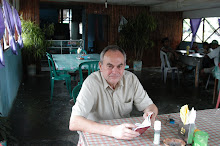 We're approaching the end of 10 dreamlike days at Totobe (Armadillo) resort on Playa San Miguel, an isolated and almost deserted 5 km long beach between 2 rocky headlands, with golden sand and backed by mangroves and palm groves. No big resort this, just a main house and annexe, ably looked after by Greivin, Wendy and Leticia and co-owned by ex-Saga colleague Jon Sandvik and his Costa Rican friend Alfredo Chinchilla. All in all a little piece of paradise, with excellent local food thrown in! Highly recommended!
We're approaching the end of 10 dreamlike days at Totobe (Armadillo) resort on Playa San Miguel, an isolated and almost deserted 5 km long beach between 2 rocky headlands, with golden sand and backed by mangroves and palm groves. No big resort this, just a main house and annexe, ably looked after by Greivin, Wendy and Leticia and co-owned by ex-Saga colleague Jon Sandvik and his Costa Rican friend Alfredo Chinchilla. All in all a little piece of paradise, with excellent local food thrown in! Highly recommended! At high tide, the surf breaks very near to the top of the beach ,and as Ros's last blog says, the sound of it pounds away in the background day and night. For the lazier of us, there's also a great little swimming pool, flanked by manicured lawns where the resident iguanas bask and enjoy the morning sun, warming up for the day's hunting. Hummingbirds gather nectar from the trees around us and pelicans fly in big Vs over us, hunting out the fish shoals just offshore. Even a crocodile was observed the other night, crossing the road on its way back to the mangroves behind the beach track, while the howler monkies bark and groan out their chorus in the background.....
At high tide, the surf breaks very near to the top of the beach ,and as Ros's last blog says, the sound of it pounds away in the background day and night. For the lazier of us, there's also a great little swimming pool, flanked by manicured lawns where the resident iguanas bask and enjoy the morning sun, warming up for the day's hunting. Hummingbirds gather nectar from the trees around us and pelicans fly in big Vs over us, hunting out the fish shoals just offshore. Even a crocodile was observed the other night, crossing the road on its way back to the mangroves behind the beach track, while the howler monkies bark and groan out their chorus in the background.....We've enjoyed a couple of longer trips, one a 50 something km trek down to the southern tip of the Nicoye peninsula at Cabo Blanco (yet again a trip made unnecessarily longer by Mrs GPS's commands!), fording rivers where the guide advises not to step out of the car onto floating logs - they may be crocodiles! And a fantastic 5 km run along pristine Playa Bongo, before hitting the somewhat rough and ready hippie/surf/backpacker resorts of Santa Teresa, Malpais and Montezuma near the southernmost tip and one of CR's first nature reserves around Cabo Blanco itself, with its luxuriant tropical forest and yet more untouched beaches. And then yesterday, 33 km northwards to Samara, a somewhat more upmarket beach resort, but along dirt and gravel roads that sometimes seem to hang miraculously onto the mountainside. Another great trip, but yet again making us more than happy to get back to magical Playa San Miguel and Totobe, to watch yet another awe-inspiring sundown over the Pacific.














